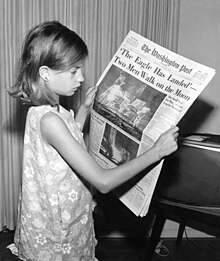Apollo 11 in popular culture
The 1969 mission's wide effect on popular culture has resulted in numerous portrayals of Apollo 11 and its crew, Neil Armstrong, Buzz Aldrin, and Michael Collins.
[5] Relations between Hungary and the United States were strained at the time, as the Hungarian crown jewels had been taken into U.S. custody after the Second World War and would not be returned until 1978.
[8] The postal service of Eire issued a commemorative €1 stamp for the 50th anniversary in 2019, but misspelled the word "gealach" (Gaelic for "Moon") as "gaelach" ("Irish"), an accidental transposition during design that was not caught in proof.
[9] The USPS issued two 50th anniversary stamps as part of its "Forever" collection, one a photograph of the Moon with the landing site marked, and the other one of Armstrong's pictures of Aldrin.
[13] But the supplied script was lengthy and stilted, the Washington Post commenting that it would have lasted "for the better part of one orbit of the moon" and resulted in "a veritable barrage of phone calls from a flabbergasted public", and NASA decided that the astronauts had enough to do; so the stamping was without ceremony.
The last time this had happened was the national day of mourning on Monday, November 25, 1963, to observe the state funeral of President John F. Kennedy, who had set the political goal to put a man on the Moon by the end of the 1960s and bring him back to Earth safely.
[52] There is a humorous and ribald urban legend that when Armstrong was a child, the wife of a neighbor named Gorsky, when asked by her husband to perform oral sex, had ridiculed him by saying "...when the kid next door walks on the Moon!"
"[55] All three major American broadcast networks, CBS, NBC and ABC had live coverage of the Moon landing.
Footage of the Moon landing was recorded on video tape at the Australian Broadcasting Commission's ABN-2 in Sydney, then rushed by an RNZAF English Electric Canberra to Wellington and WNTV1.
When the Apollo 11 landing occurred some Eastern Bloc countries (Soviet Union, North Korea and the People's Republic of China) did not broadcast live television footage of it.
[62] Eastern Bloc countries in Europe which covered the Moon landing on television live were: Yugoslavia, Romania,[63] Bulgaria, Hungary, Poland and Czechoslovakia.
